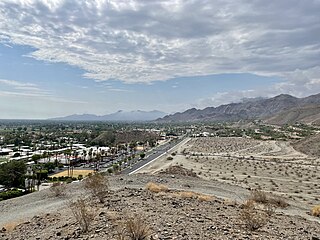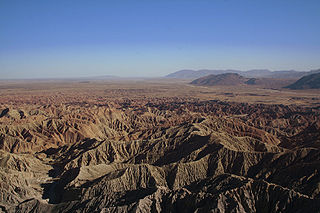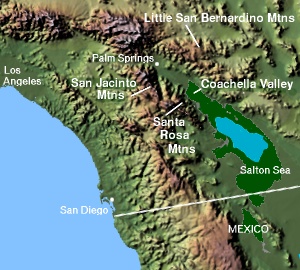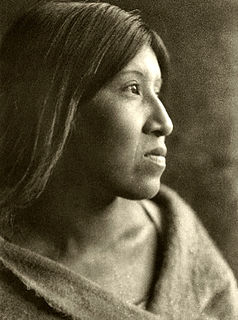
Indio is a city in Riverside County, California, United States, in the Coachella Valley of Southern California's Colorado Desert region. It lies 23 miles (37 km) east of Palm Springs, 75 miles (121 km) east of Riverside, 127 miles (204 km) east of Los Angeles, 148 miles (238 km) northeast of San Diego, and 250 miles (402 km) west of Phoenix. The word Indio is Spanish for Indian.

Rancho Mirage is a city in Riverside County, California, United States. The population was 17,218 at the 2010 census, up from 13,249 at the 2000 census, but the seasonal (part-time) population can exceed 20,000. Located between Cathedral City and Palm Desert, it is one of the nine cities of the Coachella Valley. Rancho Mirage was incorporated in 1973 from a merger of five unincorporated areas known as the "Cove communities", and had 3,000 permanent residents at the time.

Anza-Borrego Desert State Park (ABDSP) is a California State Park located within the Colorado Desert of southern California, United States. The park takes its name from 18th century Spanish explorer Juan Bautista de Anza and borrego, a Spanish word for sheep. With 585,930 acres (237,120 ha) that includes one-fifth of San Diego County, it is the largest state park in California.

The San Jacinto Mountains are a mountain range in Riverside County, located east of Los Angeles in southern California in the United States. The mountains are named for one of the first Black Friars, Saint Hyacinth, who is a popular patron in Latin America.

The Coachella Valley is an arid rift valley in the Colorado Desert of Southern California's Riverside County. The valley extends approximately 45 mi (72 km) southeast from the San Gorgonio Pass to the northern shore of the Salton Sea and the neighboring Imperial Valley, and is approximately 15 mi (24 km) wide along most of its length. It is bounded on the northeast by the San Bernardino and Little San Bernardino Mountains, and on the southwest by the San Jacinto and Santa Rosa Mountains.

The Cahuilla, also known as ʔívil̃uqaletem or Ivilyuqaletem, are a Native American people of the various tribes of the Cahuilla Nation, living in the inland areas of southern California. Their original territory included an area of about 2,400 square miles (6,200 km2). The traditional Cahuilla territory was near the geographic center of Southern California. It was bounded to the north by the San Bernardino Mountains, to the south by Borrego Springs and the Chocolate Mountains, to the east by the Colorado Desert, and to the west by the San Jacinto Plain and the eastern slopes of the Palomar Mountains.

Washingtonia filifera, also known as desert fan palm, California fan palm, or California palm, is a flowering plant in the palm family (Arecaceae) native to the far southwestern United States and Baja California. Growing to 15–20 m (49–66 ft) tall by 3–6 m (10–20 ft) broad, it is an evergreen monocot with a tree-like growth habit. It has a sturdy, columnar trunk and waxy, fan-shaped (palmate) leaves.

Mid-century modern (MCM) is an American design movement in interior, product, graphic design, architecture, and urban development that was popular from roughly 1945 to 1969, during the United States's post–World War II period. The term was used descriptively as early as the mid-1950s and was defined as a design movement by Cara Greenberg in her 1984 book Mid-Century Modern: Furniture of the 1950s. It is now recognized by scholars and museums worldwide as a significant design movement. The MCM design aesthetic is modern in style and construction, aligned with the Modernist movement of the period. It is typically characterized by clean, simple lines and honest use of materials, and it generally does not include decorative embellishments.

Edmund Carroll Jaeger, D.Sc., was an American biologist known for his works on desert ecology. He was born in Loup City, Nebraska to Katherine and John Philip Jaeger, and moved to Riverside, California in 1906 with his family. He was the first to document, in The Condor, a state of extended torpor, approaching hibernation, in a bird, the common poorwill. He also described this in the National Geographic Magazine.
The Desert Sun is a local daily newspaper serving Palm Springs and the surrounding Coachella Valley in Southern California.

Palm Springs is a desert resort city in Riverside County, California, United States, within the Colorado Desert's Coachella Valley. The city covers approximately 94 square miles (240 km2), making it the largest city in Riverside County by land area. With multiple plots in checkerboard pattern, more than 10% of the city is part of the Agua Caliente Band of Cahuilla Indians reservation land and is the administrative capital of the most populated reservation in California. Traditionally the Cahuilla refer to the Palm Springs area as Sec-he or Se-Khi.
The Calico Print was a newspaper, established in 1882 and published during the heyday of the silver mining camp of Calico, California prior to 1902. The Calico Print was also the name of a monthly, later bi-monthly, periodical of the mid-20th century, and contained "Tales and trails of the desert West."

J. Smeaton Chase was an English-born American author, traveler and photographer.

Cabot's Pueblo Museum is an American historic house museum located in Desert Hot Springs, California, and built by Cabot Yerxa, an early pioneer of the Colorado Desert. A large, Hopi-style pueblo, built in the Pueblo Revival Style, it contains artworks, artifacts of American Indian and Alaska Native cultures, and memorabilia of early desert homesteader life. The museum may also be referred to as Cabot's Old Indian Pueblo Museum, Cabot's Trading Post or Yerxa's Discovery.

Carl Eytel was a German American artist who built his reputation for paintings and drawings of desert subjects in the American Southwest. Immigrating to the United States in 1885, he settled in Palm Springs, California in 1903. With an extensive knowledge of the Sonoran Desert, Eytel traveled with author George Wharton James as he wrote the successful Wonders of the Colorado Desert, and contributed over 300 drawings to the 1908 work. While he enjoyed success as an artist, he lived as an ascetic and would die in poverty. Eytel's most important work, Desert Near Palm Springs, hangs in the History Room of the California State Library.
Peter T. Wild was a poet, historian, and professor of English at the University of Arizona in Tucson, Arizona. Born in Northampton, Massachusetts, he grew up in and graduated from high school in Easthampton, Massachusetts. Wild worked as a rancher and firefighter for the U.S. Forest Service, and served as a lieutenant with the U.S. Army in Germany. Wild earned his M.F.A. in 1969 from the University of California, Irvine. He then began teaching for nearly 40 years and wrote over 2,000 poems; also, he edited or wrote some 80 fiction and non-fiction books, largely dealing with the American West. His 1973 volume of poetry, Cochise, a eulogy to the Chiricahua Apache Indians and their leader Cochise, was nominated for the Pulitzer Prize in Poetry.
Dos Palmas Spring is an artesian spring in Riverside County, California where it lies at the foot of the Orocopia Mountains. It is only one of several such springs in the area that create an oasis in the Colorado Desert there.

Bruce Fessier is an American arts and entertainment journalist.














